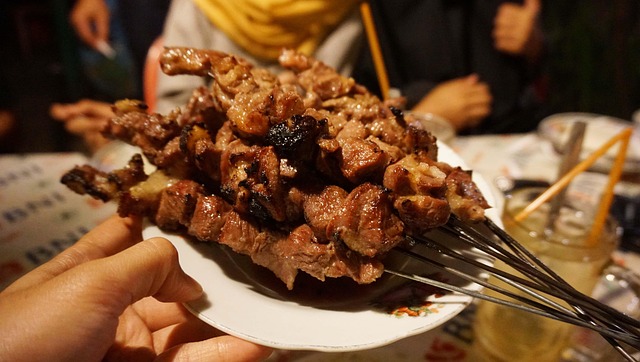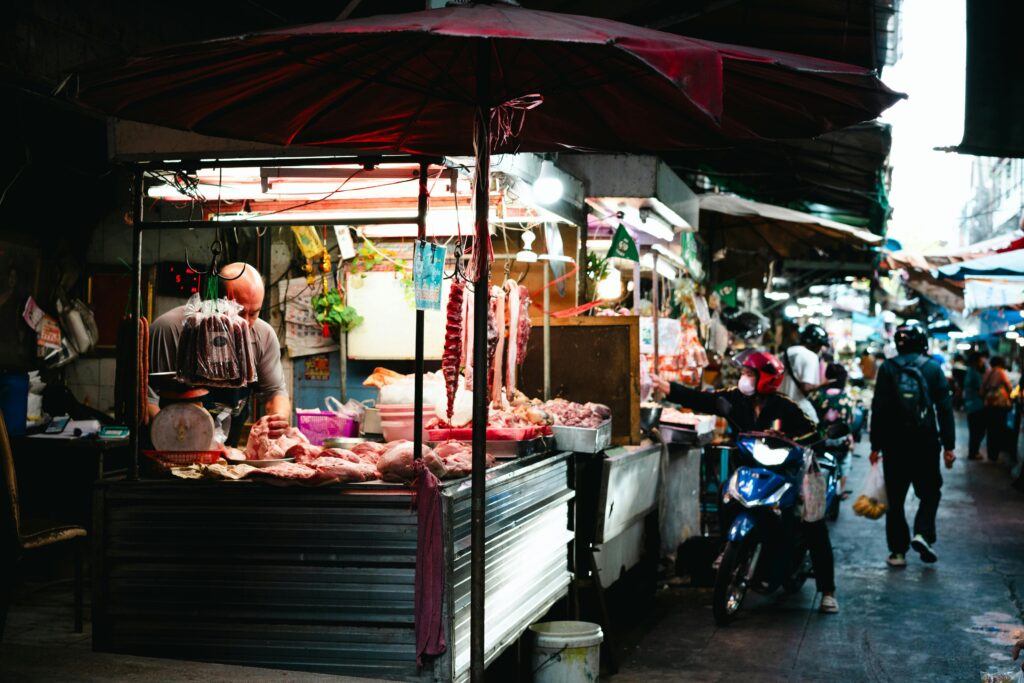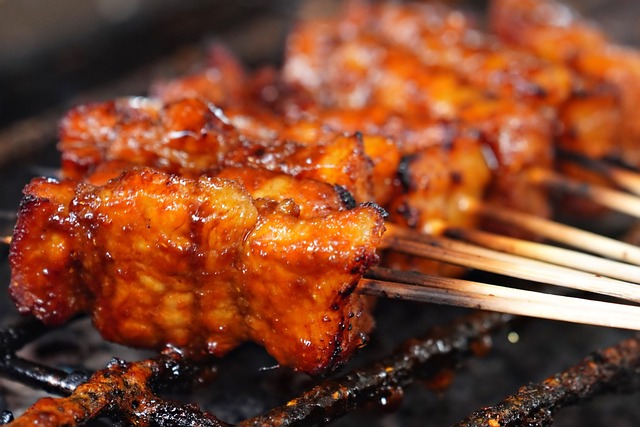The Allure of Indonesian Satay
Across Indonesia, the unmistakable scent of grilled meat wafts through bustling streets, heralding the presence of satay — the nation’s most beloved culinary symbol. Among its many regional interpretations, Sate Padang stands as a fiery ambassador of West Sumatran cuisine. Cloaked in a thick, spiced sauce and served with tender beef skewers, this dish captures not just flavor but the very heartbeat of the Minangkabau people.
Tracing the Origins of Sate Padang
The birth of satay in Minangkabau culture
In the lush highlands of West Sumatra, food has long been a vessel of storytelling. Sate Padang emerged as a reflection of Minangkabau ingenuity — a people known for their culinary artistry and strong matrilineal traditions. Influenced by trade routes that introduced exotic spices, this satay was born out of necessity and creativity: to preserve meat, enhance flavor, and celebrate communal unity.
How trade and migration shaped West Sumatran cuisine
Centuries of maritime exchange brought chili from the Americas, cloves from Maluku, and turmeric from India. The Minangkabau absorbed these ingredients into their cooking, forging a cuisine rich in color and complexity. As they migrated across the archipelago, they carried their recipes with them, turning Sate Padang into a national treasure.
From street stalls to fine dining: Sate Padang’s culinary journey

Photo by Pixabay / Free to use under license.
Once a humble street food served from smoky carts, Sate Padang has transcended class and geography. Today, it appears in both roadside warungs and high-end restaurants, its essence unchanged — a dish that bridges tradition and modernity, simplicity and depth.
Understanding the Padang Culinary Heritage
The philosophy behind Minang cooking
Minangkabau cuisine is guided by a philosophy of boldness and balance. Every dish embodies the harmony of spicy, savory, and aromatic sensations, creating a symphony that awakens the senses. Cooking, for the Minang, is not mere sustenance — it’s an act of preservation and pride.
Spices as storytelling instruments of the highlands
Turmeric, galangal, lemongrass, and chili are not just ingredients; they are historical narrators. Each spice carries tales of ancient trade, cultural fusion, and local adaptation. Their interplay in Sate Padang’s sauce forms a poetic expression of the land’s fertility and people’s resilience.
The communal spirit of Padang food traditions
In Minangkabau households, meals are communal celebrations. Food is shared from large platters, symbolizing equality and kinship. Sate Padang, though often sold individually, carries this same communal soul — a dish meant to be enjoyed together, standing side by side.
What Makes Sate Padang Unique
The art of thick, spicy yellow sauce
Unlike other satays that rely on peanut or soy-based sauces, Sate Padang’s defining feature is its golden, viscous gravy. The sauce, simmered with bone broth and infused with turmeric, chili, and aromatic herbs, creates a depth of flavor that’s both fiery and comforting.
Rice cakes instead of rice: the lontong connection

source : @basukiharis
Served not with plain rice but with compact rice cakes known as lontong, Sate Padang achieves textural perfection. The soft, chewy cubes soak up the sauce like sponges, ensuring every bite is drenched in flavor.
Why Sate Padang stands apart from other Indonesian satays
Its spice-laden sauce, beef skewers, and distinctive serving style make it unlike any other. Sate Padang is a meal that commands attention — bold, unapologetic, and layered with cultural nuance.
Regional Variants of Sate Padang
Sate Padang Panjang: the bright yellow version with turmeric flair
Renowned for its golden hue and subtle spice, Sate Padang Panjang celebrates the mellow warmth of turmeric. The flavor is refined, smooth, and aromatic — a gentle introduction for first-timers.
Sate Padang Pariaman: fiery red and full-bodied
Pariaman’s version sets tongues ablaze with an assertive red sauce. Chili dominates, creating a robust and lingering heat that demands respect. It’s the choice of spice lovers and purists alike.
Sate Padang Kota: a blend of the two, beloved in modern cities
Urban stalls often merge both traditions, offering a balanced sauce that’s equal parts golden and red — a modern compromise between subtlety and fire.
The Secret Behind the Signature Sauce
Crafting the perfect spice paste: galangal, turmeric, and chili harmony
The heart of Sate Padang lies in its bumbu — a meticulously ground paste of galangal, ginger, turmeric, lemongrass, and red chilies. Each component is sautéed slowly until fragrant, releasing oils that form the dish’s foundation.
The role of rice flour in achieving creamy consistency
Rice flour acts as a natural thickener, giving the sauce its silky body without overpowering the spices. The result is a gravy that clings luxuriously to every skewer.
Techniques to balance heat, fragrance, and umami
The challenge lies in restraint. Too much chili masks the fragrance; too little makes it dull. Achieving harmony is a culinary art, one perfected through generations of patient cooks.
Selecting and Preparing the Meat
Choosing the ideal beef cuts for tenderness
Beef tongue, brisket, or shank are favored for their texture and flavor. Each cut, slow-cooked until tender, absorbs the spiced broth like a sponge, transforming into succulent perfection.
Traditional marination rituals and overnight soaking
Marinating the meat overnight in spices ensures deep penetration and a full-bodied taste. Time, here, is as vital as seasoning.
Grilling over charcoal: the smoky transformation
Once skewered, the meat meets glowing charcoal. The fire’s kiss imparts a smoky aroma that defines authentic Sate Padang — an alchemy of heat and patience.
From Market to Skewer: A Culinary Ritual
Sourcing fresh local ingredients in West Sumatra
Vendors begin their day at dawn, handpicking cuts of meat, herbs, and chilies from local markets. Freshness dictates quality, and every detail matters.
The rhythmic preparation of hundreds of skewers
Each skewer is assembled with precision, a labor of repetition and rhythm. The sight of rows of glistening meat waiting for the grill is nothing short of hypnotic.
The aroma of satay smoke wafting through Padang’s streets
As the sun sets, the smoky fragrance fills the air. It draws crowds instinctively — locals and travelers alike — to the source of that irresistible scent.
Sate Padang and Its Iconic Companions

Photo by Pixabay / Free to use under license.
Lontong: the soft, starchy partner in every bite
The lontong’s neutral flavor tempers the spice, allowing the sauce to shine. Together, they create balance — a perfect duet of heat and calm.
Sambal lado: optional heat for daring palates
For those unafraid of intensity, sambal lado offers an extra layer of fire. It’s not just a condiment but a statement of courage.
Complementary sides and local drinks to cool the spice
Sweet iced tea or es cincau (grass jelly drink) often accompanies the dish, soothing the tongue and completing the sensory experience.
Street Food Culture of Padang

Photo by Pixabay / Free to use under license.
The symphony of sizzle and chatter at night markets
The night markets of Padang pulse with life. The clatter of skewers, bursts of laughter, and sizzle of grills merge into a symphony of sensory delight.
Street vendors as cultural storytellers
Every vendor tells a tale — of family recipes, local pride, and survival. Through their food, history is kept alive.
How Sate Padang became an emblem of homecoming
For those returning to West Sumatra after time away, the first taste of Sate Padang is a return to roots, a warm welcome from one’s homeland.
Modern Interpretations and Urban Adaptations
Fusion twists in Jakarta’s culinary scene
Chefs in Jakarta have experimented with Sate Padang tacos, wraps, and sliders — creative reinterpretations that preserve its essence while courting new audiences.
Vegan and chicken-based alternatives gaining popularity
Innovators now craft versions with tempeh, mushrooms, or chicken, proving that the spirit of Sate Padang transcends its traditional boundaries.
How social media revived traditional Sate Padang stalls
Instagram and TikTok have breathed new life into old recipes. Viral videos of sizzling skewers have sparked renewed appreciation among the youth.
The Cultural Symbolism of Sate Padang
A dish of identity, pride, and diaspora nostalgia
For the Minangkabau diaspora, Sate Padang is more than sustenance — it’s a nostalgic tether to home. Each bite recalls family kitchens and ancestral warmth.
The role of satay in communal gatherings and family feasts
No celebration is complete without it. From weddings to religious festivities, Sate Padang signifies togetherness and gratitude.
How Sate Padang represents resilience in taste
Its enduring popularity is proof of cultural endurance — a recipe that has survived wars, migrations, and modernization without losing its soul.
Health and Nutritional Perspectives
The benefits and balance of traditional ingredients
Turmeric and galangal boast anti-inflammatory properties, while lean beef offers protein-rich sustenance. The dish nourishes as much as it delights.
Managing the spice: nutrition meets indulgence
Though spicy, the balance of heat and flavor encourages mindful eating — savoring, not devouring.
Health-conscious adaptations in contemporary kitchens
Modern cooks often reduce oil and salt or swap beef for leaner meats, maintaining essence while embracing wellness.
Sate Padang Beyond Borders
Indonesian restaurants introducing it to the world
From Amsterdam to Sydney, Indonesian eateries proudly serve Sate Padang, introducing global palates to its unique heat and texture.
The global fascination with fiery, complex flavors
In an age where culinary adventurers crave authenticity, Sate Padang satisfies that yearning with unapologetic intensity.
How expatriate communities keep the tradition alive abroad
Diaspora communities recreate it in their kitchens, blending nostalgia with new influences while preserving the sacred recipe.
Cooking Sate Padang at Home
Essential tools and utensils for authenticity
Charcoal grills, bamboo skewers, and stone mortars are essential — the tools of heritage that shape both texture and taste.
Step-by-step overview of the cooking process
Simmer the beef, grind the spices, prepare the broth, thicken it with rice flour, grill the meat, and pour the fragrant sauce over it. Simplicity meets devotion.
Common mistakes and how to avoid them
Rushing the simmering or over-thickening the sauce can ruin the harmony. Patience remains the most vital ingredient.
Pairing Sate Padang with Drinks and Desserts
Cooling coconut beverages to balance the spice
Coconut-based drinks like es kelapa muda offer instant relief from the heat, complementing the dish’s fiery nature.
Traditional sweets that complete the experience
Delicacies like kue lupis or dadar gulung bring sweetness to the palate, softening the lingering spice.
Modern beverage pairings for the adventurous eater
Craft beers, iced lattes, or sparkling teas have become trendy accompaniments, merging tradition with modern indulgence.
The Economic and Social Role of Sate Vendors
Street vendors as micro-entrepreneurs of flavor
Each stall represents a small-scale business built on craftsmanship and community trust. They are the guardians of culinary authenticity.
The daily hustle behind every skewer
Long hours, unpredictable weather, and fierce competition define their livelihood. Yet their dedication never falters.
How Sate Padang sustains local livelihoods
Beyond taste, it sustains families, finances education, and strengthens the fabric of Padang’s local economy.
Festivals and Celebrations Featuring Sate Padang
Religious and cultural events where Sate Padang shines
From Eid to local harvest festivals, Sate Padang is served as a centerpiece of joy and gratitude.
Symbolic meanings during special occasions
The dish embodies abundance, warmth, and the reward of hard work — a culinary metaphor for life itself.
How food unites communities across generations
Each celebration becomes a bridge, connecting the elders who perfected the recipe with the young who inherit it.
Preserving Tradition in a Modern World
Efforts to document and protect culinary heritage
Culinary historians and chefs are working to archive traditional techniques, ensuring Sate Padang endures beyond oral memory.
The next generation of Padang cooks and innovators
Young chefs are reimagining the dish with modern aesthetics while remaining faithful to its roots.
Challenges in maintaining authenticity amid globalization
As international tastes evolve, the battle lies in adaptation without dilution — preserving heritage in a fast-changing culinary landscape.
Conclusion: Sate Padang as a Taste of Heritage
A reflection on flavor, memory, and cultural endurance
Each skewer tells a story — of earth, fire, and tradition. Sate Padang is not merely eaten; it is experienced, savored, and remembered.
Why Sate Padang remains a timeless Indonesian masterpiece
Through centuries of change, it has endured as a testament to West Sumatra’s culinary genius — a dish that binds past and present, one fiery bite at a time.




